Exploring the Brotherhood of Steel's Lore in Fallout
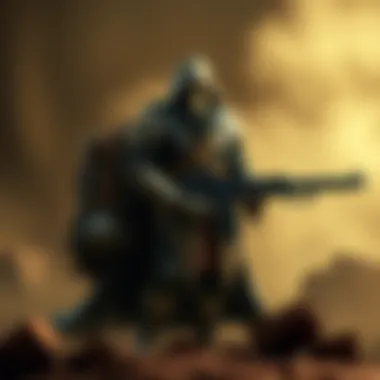
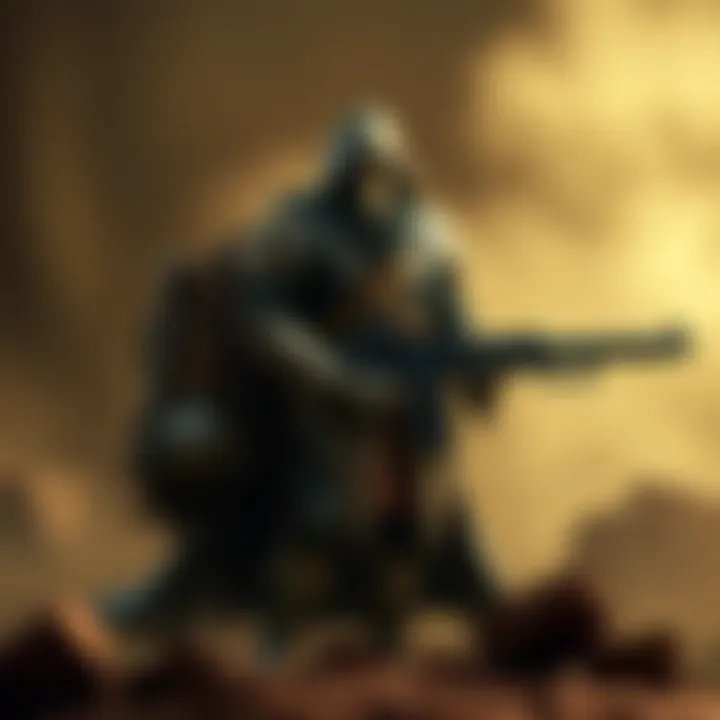
Intro
The Fallout universe, steeped in a rich history of its own, serves as a fertile ground for storytelling, especially through its myriad of factions, such as the Brotherhood of Steel. This militant group, born from the ether of a conflict-ridden post-apocalyptic society, has captured the imaginations of gamers and lore enthusiasts alike. Their scattered letters—like breadcrumbs left behind in the desolate wasteland—offer an intriguing glimpse into their philosophies, internal disputes, and interactions with other factions. Through these epistles, we delve deeper into the complex fabric that weaves the Brotherhood’s identity, revealing the multifaceted implications of their actions on the broader narrative of the Fallout series.
In examining the Brotherhood's lore, we navigate the landscapes they’ve traversed, uncovering historical events that shaped their ideologies. With the help of these letters, a keen insight is afforded, not only into the Brotherhood's collective conscience but also into the struggles they face amid their scattered ranks. The letters invite readers to become part of an ongoing conversation about morality, technology, and human existence—themes that resonate far beyond the game itself.
This article promises to unfold the complexities of the Brotherhood through careful scrutiny, making connections that reflect both the historical and modern implications of their existence in a world decimated by nuclear war. Join us as we sift through the remnants of their correspondence and unearth the narratives that lie within.
Lore Insights
Overview of the Fallout Universe
At its core, the Fallout universe depicts a world where humanity is grappling with the aftermath of nuclear devastation. Established in an alternate timeline that diverges from our reality, the Fallout series introduces players to a landscape filled with mutants, raiders, and remnants of pre-war civilization. The folklore of the Brotherhood of Steel cannot be understood without recognizing the chaos that envelops the post-apocalyptic world.
Key Historical Events in the Fallout Timeline
Throughout the series, significant historical events lay the groundwork for the Brotherhood's formation and growth. A couple of pivotal moments include:
- The Great War (2077): A catastrophic nuclear war that wiped out most of humanity and left the world in ruins.
- Formation of the Brotherhood (2220): Initially formed to protect technology and maintain a semblance of order in a chaotic world.
Each letter penned by the Brotherhood reflects their response to these historical scars, revealing insights into how they reconcile their past with present conflicts.
Deep Dive into the Backstory of Major Factions and Characters
The Brotherhood stands as a beacon of hope and a harbinger of conflict. Understanding their context means diving into their backstory and relations with other factions such as the Enclave and the Railroad. They view technology as a lifeline, but this perspective often puts them at odds with those who seek to use it differently. The letters provide a unique platform to discuss these rivalries and alliances, showcasing the intricate web of relationships that define their mission.
"In their pursuit of the preservation of technology, the Brotherhood often walks a high wire between savior and tyrant."
By examining these perspectives, players gain a holistic view of the moral dilemmas that the Brotherhood navigates, challenging fans to ponder the ethical ramifications of their choices.
Intro to the Brotherhood
The Brotherhood of Steel represents a significant faction in the Fallout universe, but to grasp their full essence, we must first understand their origins, core values, and beliefs. This introductory segment serves not just as a prelude but as a guiding light through the labyrinth of narratives that define this storied group. The Brotherhood has established itself not merely as a collection of warriors but as a resilient bastion of knowledge amidst the chaos. The writings, letters, and communications that have scattered throughout the wastelands are more than just words; they offer insights into their struggles, ambitions, and the philosophical underpinnings that guide them.
By exploring the roots and values of the Brotherhood, readers gain a clearer picture of their role in the overall Fallout saga. This is crucial as it lays the groundwork for understanding their actions, decisions, and conflicts, which ripple through the plot and player experiences alike. The exploration of themes such as duty, preservation of technology, and ethical dilemmas not only enhances the narrative but also resonates on a more personal level for those who dare to walk through the wasteland. It allows players and fans alike to connect emotionally with the Brotherhood’s journey and evolution.
Origins of the Brotherhood
The origins of the Brotherhood are steeped in a mix of militaristic ethos and the quest for knowledge. Formed in the wake of the Great War, it sprouted from a group of disparate survivors, primarily members of the United States military and technology experts seeking to protect the remnants of human civilization. The catalyst for their formation was a shared vision: to safeguard advanced technology from falling into the wrong hands, understanding that such power could easily be perverted in a lawless world. This mission resonated deeply, creating a foundation that emphasized both duty and the weight of responsibility.
These individuals banded together, embracing a creed that not only valued strength in combat but also reverberated with the importance of knowledge preservation. Indeed, their early days were marked by an eagerness to accumulate as much technological knowledge as they could find. This thirst for wisdom over brute force set them apart from other factions that were primarily focused on survival at any cost.
Understanding the historical context gives depth to their narrative. The letters exchanged among the founders and early members contain philosophies that articulate their fears, aspirations, and uncertainties in a world that seemed dark and forbidding. Each letter acts like a timestamp, capturing the essence of the moment, the hopes for the future, and worries for their past. A glimpse into these texts reveals how deeply their origins shaped their identity.
Core Values and Beliefs
At the heart of the Brotherhood’s existence is a constellation of core values that not only guide their actions but also provide a moral compass amid chaos. Central among these principles is the belief in the preservation of technology. For the Brotherhood, technology is not merely a tool; it represents humanity's progress and potential. They view themselves as the stewards of this knowledge, ensuring that it does not get tangled in the treacherous hands of those who would misuse it for nefarious purposes.
Another salient belief revolves around unity and loyalty. Brotherhood members swear an oath, reaffirming their dedication to each other as well as to the larger mission. This intensity of loyalty fosters a strong familial bond among its members, often leading them to make personal sacrifices for the greater good of the whole.
Lastly, the concept of a rigorous moral code is particularly significant. Underpinning their values is an acute awareness of the complexities of power and responsibility. They often deliberate on questions that other factions might dismiss too lightly. For instance, how far should one go to protect their ideology? Should they impose their beliefs on others, or should they allow freedom of choice? Such questions permeate their letters and communications, reflecting an ongoing internal struggle between their ideals and the reality they face.
"We are not heirs to humanity’s past. We are its guardians, tasked with a solemn duty to ensure its future."
This sentiment encapsulates the Brotherhood's mission as they navigate the delicate balance between protection and oppression, as their journey unfolds through the carefully penned thoughts in their scattered letters.
The Dispersal of Letters
The scattered letters of the Brotherhood serve as more than just remnants of a bygone era; they are vital threads that weave together the complex narrative of their existence. In a post-apocalyptic world, communication becomes a means of preservation, a way to convey wisdom or caution. The letters found throughout the Fallout universe highlight the Brotherhood's philosophies, struggles, and alliances, acting as an emotional anchor that gives depth to their lore.
Understanding the significance of these letters provides insights into the human condition, even amidst devastation. This written correspondence encapsulates the Brotherhood's ethos and reflects their ongoing quest for identity in a fragmented landscape. For fans looking to unearth the layers of the Brotherhood's story, analyzing these letters becomes an essential pursuit.
Purpose of Written Communication
Written communication within the Brotherhood serves as a lifeline, a bridge connecting their past with the present. These letters are far from mere scripts; they embody the thoughts, hopes, and fears of individuals striving for survival. First, they offer a platform to share knowledge, preserving essential information regarding their practices and beliefs. For instance, a letter detailing the protocols for sharing technology underscores the Brotherhood's commitment to safeguarding human heritage.
Moreover, the letters also act as chronicles of personal experiences. Each meticulously penned note captures the emotional weight of its author's journey. A soldier's final words or a leader's desperate plea can resonate across time, reminding readers that the emotional landscape of the Brotherhood is as varied as the wasteland itself.
Communicating through letters allows members to articulate their struggles and triumphs, conveying the nuances of their ideology. The power of the written word strengthens their bonds, fostering unity in the face of adversity. In essence, the purpose of these letters transcends mere documentation; they allow the Brotherhood's members to assert their identities and shared motivations in a chaotic world.
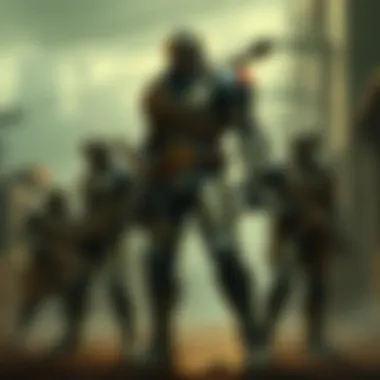
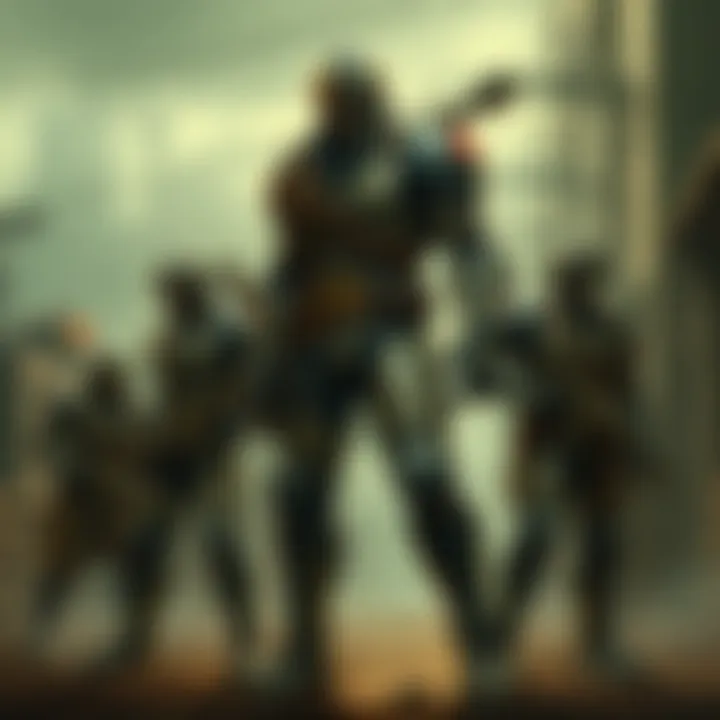
Historical Context of the Letters
To grasp the true essence of the Brotherhood's letters, one must consider the era in which they were written. Set against the backdrop of a ravaged world after nuclear fallout, these communications shed light on the sociopolitical climate of their time. In formations built on ideals of security and order, the Brotherhood's letters become artifacts reflecting their philosophical underpinnings and internal divisions.
From the early days following the Great War, when survival was paramount, to the later stages where political maneuvering took hold, each letter captures a snapshot of the Brotherhood's evolution. The conflicts with factions and the shifting dynamics shaped their storytelling as well. Understanding the historical context in which these letters were penned provides a richer comprehension of the tasks and trials the Brotherhood faced.
For example, letters exchanged among leaders reveal disagreements on the direction the Brotherhood should take. The shifting allegiances and rivalries with others, like the New California Republic, add layers to the narrative. This correspondence not only sheds light on their alliances but also illustrates fractures within the Brotherhood itself.
In summary, the historical context of these letters amplifies their significance. No longer mere words, they become a window into a dramatic saga that continues to unfold. A deeper understanding of the circumstances surrounding these texts enhances an appreciation for the Brotherhood's narrative arc within the wider Fallout series.
Philosophical Underpinnings in the Brotherhood's Writings
The philosophical framework woven throughout the correspondence of the Brotherhood of Steel sheds light not only on their values but also their internal struggles and aspirations. The Brotherhood’s letters often serve as a manifesto of sorts, reflecting a complex tapestry of thought influenced by their history and the dire circumstances surrounding them within the Fallout universe. At the core of these writings lies a distinct perspective on humanity, technology, and power, all of which are instrumental in understanding the Brotherhood's evolution and its role in the broader narrative of survival.
Struggles for Continuity
The letters from the Brotherhood frequently reveal a deep-seated yearning for continuity—a desire to uphold traditions amid the chaos of a shattered world. Each missive often underscores the belief that they are the stewards of lost knowledge, advocates for a future that embraces the technological advances before the Great War. This ideal clashes with reality; the Brotherhood’s members experience internal frictions that threaten their cohesive identity. Over time, the letter exchanges among members reflect an ongoing debate about adherence to these founding principles versus adapting to new realities.
The struggle for continuity manifests in several ways:
- Intergenerational Tensions: Older members often critique the younger ones for perceived laxity in adhering to the Brotherhood’s tenets, fearing that the essence of their organization is fading.
- Philosophical Divergence: Different factions within the Brotherhood interpret the philosophies embedded in their doctrine in various ways; some view technological preservation as paramount, while others prioritize human welfare.
- Historical Reflection: Letters recall past glories and tragedies, creating a narrative that binds the Brotherhood's present to its storied past.
These elements are not just mere words on paper; they resonate deeply with members and provide a framework to navigate this fractured reality. The letters become a mirror of their inner conflicts, capturing this timeless quest for identity and purpose.
The Dual Nature of Power
Power, in the letters of the Brotherhood, is described not merely as a tool for dominance but as a double-edged sword. Members wrestle with the implications of wielding such power; it can either fortify their goals or lead to moral decay. Within this context, power emerges as a theme that invites scrutiny and contemplation.
In examining the dual nature of power, the Brotherhood grapples with these contrasting elements:
- Instrument of Order: Power is viewed as necessary to impose structure and ensure survival in lawlessness. The Brotherhood's internal hierarchy often reflects this belief, as they seek to maintain discipline among ranks to preserve unity.
- Corruption and Hubris: The potential for corruption looms large. Historical references made in letters often caution against the perils of absolute power, recalling instances where ambition led to internal decay and division.
- Ethical Implications: Many letters postulate whether power should be pursued or wielded in moderation. There are calls for reflection on the kind of authority the Brotherhood should embrace. Is it simply to retain control, or should it extend towards enlightenment and inclusion?
Through these letters, the Brotherhood delineates its nuanced understanding of power, making it clear that mastery over technology and people comes with significant ethical responsibilities. The communication encapsulates a philosophical debate that echoes beyond the pages—one that resonates with the broader narratives of governance and authority in any era.
"Power is a necessary burden we carry, entwined with our mission and our fate. It can build empires or shatter ideals. We choose what we construct, and what we destroy."
This passage from one of the letters showcases the existential reflection prevalent in their writings, capturing the essence of their philosophical struggle. The correspondence is more than just a record; it is an exploration of the human condition in the wake of catastrophe.
Key Figures Behind the Letters
The significance of the key figures behind the letters scattered throughout the lore of the Brotherhood cannot be overstated. These individuals function not just as authors of the communication but also as harbingers of the Brotherhood’s ethos and the complexities that thread its history. Their writings are like windows, offering glimpses into their thoughts, motivations, and the challenges they faced, which all contribute to a richer understanding of the Brotherhood's identity in the post-apocalyptic landscape of Fallout.
The stories and philosophies laid out in these letters form the backbone of the Brotherhood's narrative, illustrating how personal beliefs intertwine with the collective values of the faction. Understanding these figures sheds light on both the triumphs and trials the Brotherhood endured, as well as the evolving dynamics within their ranks as they navigated a world riddled with chaos.
Prominent Leaders and Their Writings
Prominent leaders, such as Maxson and Elder Lyons, set the tone for their generations through letters that articulate not only their strategies but also their soul. Take, for instance, the Elder Maxson’s correspondence strategies that painted a vision of unity and strength. His letters often addressed the importance of the Brotherhood's mission and the necessity of combat readiness. These writings serve as imperative guides on strategic military placement and community engagement with other factions, portraying a balance between aggression and diplomacy.
Another significant figure, Elder Lyons, often expressed a more progressive vision for the Brotherhood's future. Through his letters, he urged members to reconsider their stance on isolationism. One can find his musings on cooperation and engagement to combat the greater evils in the wasteland. This approach diverged from traditional doctrines, demonstrating an evolution in Brotherhood thinking that, for some, might appear controversial.
These pieces of communication reveal the progression of ideas and ideologies that each leader championed, reflecting the pressures of their environments and the dire need for adaptability. The varied perspectives offered by these powerful figures showcase not just their ambitions but the fluctuating nature of the Brotherhood's purpose.
Less Known Members and Their Perspectives
Shifting the focus to lesser-known members, one uncovers a trove of perspectives that reiterate the Brotherhood's complexity. For example, the letters from lower-ranked members serve a different purpose, often humanizing the broader narrative and reflecting the experiences of those caught in the gears of the Brotherhood's machinery. These writings frequently touch on the internal conflicts and personal dilemmas faced while serving a larger ideal that sometimes feels too far from reach.
Consider the letters penned by scribe Danvers, who documented the struggle of reconciling personal beliefs with Brotherhood ideals. His correspondence speaks to the daily life of a member with aspirations that sometimes clash against the established order. This kind of writing acts as a mirror, reflecting the thoughts of those whose voices may be drowned out in the grand halls of power.
Additionally, the letters of Paladin Cormac reveal insight into the often-ignored nuances of loyalty, sacrifice, and fear amongst the Brotherhood ranks. Through his words, readers gain an understanding of how members relate to one another not just as soldiers in a cause but as individuals wrestling with their place in a crumbling world.
"Every letter is a testament to the lives entwined within the Brotherhood. Some dream of glory while others merely endure, and both stories deserve retelling."
These writings meld into a rich tapestry of experiences that together narrate the Brotherhood's broader saga. By exploring both the prominent and lesser-known figures, readers can appreciate the faction's multifaceted nature and the human experiences that underpin its continuing legacy.
The Conflict between Ideals and Reality
The clash between the ideals that the Brotherhood of Steel espouses and the stark reality of their existence serves as a core theme in understanding their narrative arc. This conflict is not merely academic but resonates deeply with players navigating the intricate web of morality, purpose, and survival within the Fallout universe. The Brotherhood, rooted in lofty principles of honor, preservation of technology, and the protection of humanity, often finds itself at odds with the chaos of the post-apocalyptic world. This juxtaposition offers rich material for both exploration and analysis.
Internal Strife and Division
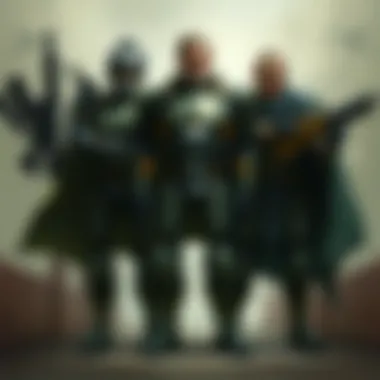
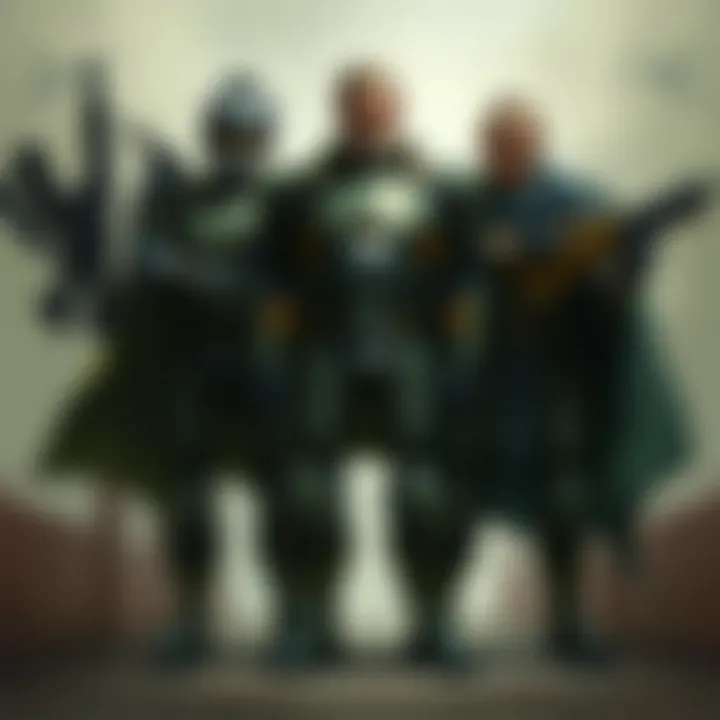
Internal strife is the name of the game when it comes to the Brotherhood's inner workings. Dissent within the organization manifests in various ways, impacting its members and their mission. Ideals that once united them often lead to division. For instance, younger members, influenced by the harsh realities of their environment, frequently challenge the elder state, advocating for more pragmatic approaches to survival. This generational gap creates a breeding ground for conflict.
Key issues often at the heart of disputes include:
- Technological Preservation vs. Accessibility: Some members staunchly believe that technology should remain in the hands of a select few. Others argue that access to technology should be expanded to help the common populace.
- Moral Absolutism vs. Pragmatism: The tension between a strict moral code and the need to make difficult choices leaves a mark. This philosophical divide can lead to rifts that jeopardize mission coherence.
In light of these divisions, letters exchanged among members bring to light differing viewpoints. Within these writings, one can observe the struggle for power as various factions attempt to sway opinions and gain influence. This turmoil may lead to disillusionment for those who remain idealistic.
Impact on Brotherhood Dynamics
The impact of this internal discord runs deep, shaping the Brotherhood's dynamics and operational effectiveness. The coexistence of various ideological camps can lead to:
- Fragmentation of Leadership: With factions competing for control, leadership is often undermined. Different leaders may prioritize divergent goals, causing strategic drift.
- Distrust Among Members: When different factions vie for influence, suspicion runs rampant. Trust, which is crucial for any organization, finds itself strained. Members often second-guess each other's intentions, leading to hesitancy in collaboration.
- Eroding of Core Values: As practical challenges mount, the guiding principles of the Brotherhood may get obscured. The long-term vision deteriorates when day-to-day survival takes precedence.
"When the ideal meets the ground reality, all too often, dreams lie in tatters."
In examining these dynamics, we see how deeply the conflict between ideals and reality shapes the Brotherhood's identity. Their mighty letters, reflecting their personal struggles and insights, become not just lines on paper, but crucial elements in the ongoing saga of a fractured brotherhood. The lessons drawn from this conflict echo through history, providing a cautionary tale about the importance of unity in navigating a world rife with conflict and complexity.
Relationships with Other Factions
Understanding the relationships of the Brotherhood of Steel with other factions adds layers of complexity to their narrative in the Fallout universe. These connections heavily influence their maneuvers and philosophies, shaping both their identity and the world around them. The Brotherhood, often perceived as a singular entity, actually operates more like a chess player in a game where alliances and rivalries can shift the board dramatically.
Through letters and communications, we observe how these relationships are not just incidental; they are pivotal in unfolding the broader implications of the Brotherhood’s goals and ideals. Whether cooperating with allies or opposing rivals, the Brotherhood’s choices reflect both strategic interests and philosophical beliefs.
Allies and Collaborations
The Brotherhood does not navigate the wasteland alone. They form alliances with various factions at different points, each with their own advantages. For instance, in some narratives, they collaborate with remnants of the United States government or tech-savvy factions like the Railroad. \
These alliances often emerge from a shared interest in preserving technology and humanity, the bedrock of the Brotherhood’s mission. The Mutual Defense Pact with these parties highlights their inclination toward shared goals – albeit with a pinch of skepticism, since trust is as rare as a clean water source in the post-apocalyptic landscape.
Consider how the Brotherhood's letter writings reveal their perceptions of these allies. They offer insights into collaboration dynamics and strategic support that go beyond surface-level agreements. Such documents often articulate the Brotherhood's expectations and reservations about their collaborators, deepening our understanding of their political maneuvering. In a world of uncertainty, these alliances are crafted with a dual awareness of potential gains and inevitable betrayals.
Rivalries and Conflicts
Contrasting with the notion of allies are the rivalries and conflicts that challenge the Brotherhood at every turn. Historically, their most significant opposition comes from factions like the Enclave or the Institute, whose contrasting ideologies amplify the Brotherhood's struggle. This enmity exemplifies the dramatic clash between preservation and innovation, with each faction embodying a starkly different vision for humanity's future.
Letters exchanged during these conflicts reveal much about the Brotherhood's mentality. They often demonstrate a mix of disdain and contempt for those they view as threats. For example, correspondences with Enclave members expose how the Brotherhood regards their methods as ruthless and counterproductive.
"In our pursuit to safeguard humanity, we cannot afford to align ourselves with those who see people merely as experiments," one letter remarked, encapsulating their stark opposition to the methods employed by their rivals.
Moreover, these rivalries are not only about direct battles; they also involve propaganda and psychological warfare. The Brotherhood often uses their written communications to frame their enemies negatively, attempting to sway public opinion, sway potential allies, and solidify their narrative in the wasteland.
In summary, the Brotherhood's relationships with other factions showcase a complex tapestry of alliances and rivalries that are deeply emblematic of their identity. The letters exchanged illustrate these interactions, providing a crucial lens through which we can grasp the intricacies of their strategies and existential conflicts in a world riddled with uncertainty.
Cultural Significance of the Letters
The letters exchanged within the Brotherhood of Steel serve as more than mere written communication; they embody cultural artifacts that reflect the values and ideologies of a fractured society. In a landscape scarred by war and its aftermath, these writings preserve a sense of identity among the Brotherhood. As members scatter across the ruins of civilization, their penned thoughts offer insight into their struggles, hopes, and the collective memory of their order.
The significance of these letters lies in several compelling elements:
- Preservation of Knowledge: One of the foremost roles these letters play is that of custodian of historical knowledge. Each letter acts as a time capsule, capturing a moment in the lives of its writers — from tactical reports to philosophical musings. These snippets of information are invaluable for understanding how the Brotherhood views its past, its current challenges, and its vision for the future.
- Reinforcement of Identity: In a world of chaos, identity often becomes fluid. The letters work to solidify the Brotherhood's identity, reminding members of their core principles and commitments. Through their writings, they articulate a shared history, cultivating a sense of belonging amidst scattered factions.
- Cultural Reflection: These writings also mirror the socio-political tensions of their time. The evolving language and themes within the letters highlight societal changes. Cultural shifts within the Brotherhood can often be traced through the nuance in how members express their thoughts on unity, duty, and the ramifications of their actions on others.
"A letter may travel across the wasteland, but the ideas within it journey through time, connecting us to our purpose."
In summary, the letters of the Brotherhood are not just relics of their time; they influence their culture significantly. Through their exchange, we glean how communication shapes beliefs and reinforces traditions, ultimately acting as a bridge between generations.
Norms and Traditions Influenced by Writings
Understanding how letters shape the norms and traditions within the Brotherhood is imperative. These writings epitomize several conventions that members embrace:
- Codifying Rituals: The letters articulate rituals that have become synonymous with Brotherhood identity, such as the initiation ceremonies. Through carefully penned correspondence, members pass down these traditions, allowing each new generation to understand its meaning.
- Language as a Symbol: The specific phrases and terminologies exclusive to the Brotherhood reinforce cohesion among members. When these unique patterns of speaking are documented, they create a linguistic barrier that symbolizes loyalty and belonging, ultimately fostering a sense of unity across disparate locations.
- Moral Guidelines: Many writings specify ethical considerations that shape behavior, dictating how members are expected to conduct themselves. The letters often captivate teachings on sacrifice, loyalty, and service to the community; these moral imperatives create a cultural guideline that members find it difficult to deviate from.
The traditions born from these writings not only serve to maintain the Brotherhood's legacy but also reinforce a shared cultural identity that withstands the test of time.
Narrative Techniques in Correspondence
Examining the writing styles utilized in the letters reveals a deeper understanding of the emotional and psychological dimensions experienced by the Brotherhood. The narrative techniques employed often expose the intricacies of their interpersonal dynamics:
- Imagery and Metaphors: Many letters encapsulate complex thoughts using vivid imagery and metaphors. By employing expressive language, writers can convey profound emotions or strategic ideas effectively, allowing even those distant from the source to understand the broader implications.
- First-Person Narration: The use of first-person perspective in some letters creates an immediacy that draws the reader into the experiences of the writer. This immersive style personalizes the conflicts and triumphs, making the Brotherhood's struggles more relatable.
- Fragmentary Style: In stark contrast to polished narratives, some letters reflect the chaos of their environment, presenting thoughts in jagged snippets. This style mirrors the disorganization of their world, emphasizing raw emotions and unrefined thoughts that enhance the authentic feel of the correspondence.
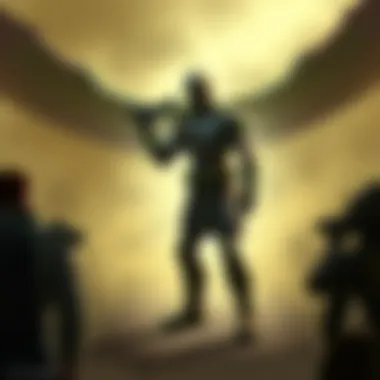
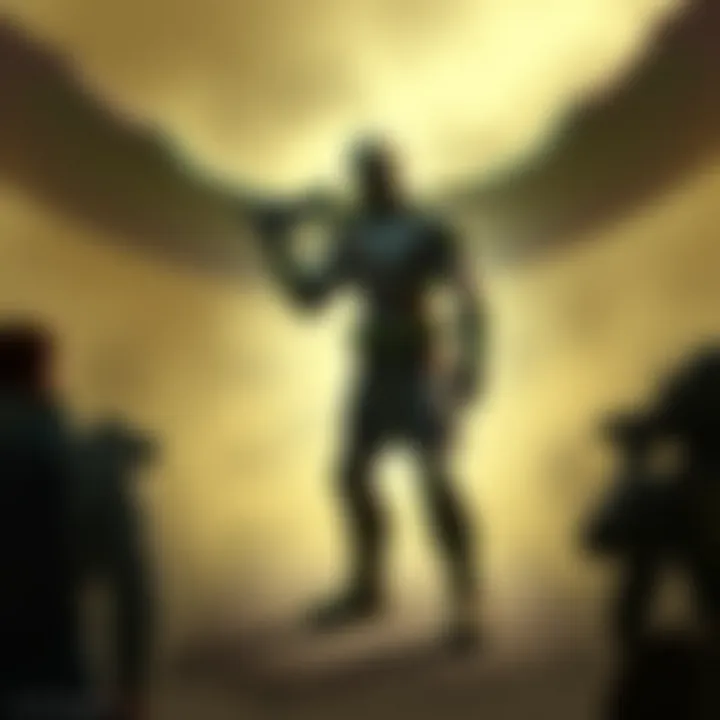
By analyzing these techniques, readers begin to appreciate the breadth of emotions and the layered meanings embedded within the Brotherhood's written words. The letters become rich narratives that articulate struggles but also weave a larger story about survival in an unforgiving world.
Psychological Implications of Communication
Communication among the Brotherhood is more than mere exchange of letters; it reveals deep psychological layers shaped by their environment and the experiences that define them. The scattered letters of the Brotherhood carry weight that extends beyond their words, embodying the collective psyche of a group navigating a harsh and unforgiving world. The psychological implications of this communication can be observed through various lenses, helping us understand how individuals cope and connect despite the challenges posed by their fragmented existence.
Letter Writing as a Coping Mechanism
In the Brotherhood's context, letter writing serves as a powerful coping mechanism. This form of expression allows members not only to articulate their thoughts but also to channel emotions that might otherwise remain bottled up. When faced with turmoil—be it inter-faction conflicts or the internal struggle of identity—crafting a letter helps individuals find clarity in chaos. It is as if each written piece becomes a diary entry, a moment of reflection in a tumultuous journey.
For instance, consider a soldier who has witnessed the horrors of battle. Writing a letter to a fellow Brotherhood member can facilitate catharsis, providing an outlet for their grief, anger, and confusion. These letters often include:
- Personal struggles: Accounts of fear, doubt, and resilience.
- Philosophical musings: Reflections on the Brotherhood’s principles and one's own beliefs about them.
- Calls for unity: Invocations of solidarity to combat individual disillusionment.
Ultimately, letter writing emerges as a therapeutic process, allowing Brotherhood members to bridge the gap between personal and communal experiences—a vital aspect of maintaining their identity in a fractured world.
Emotional Resonance across Eras
The emotional content imbued in these letters transcends time, resonating through different eras of the Brotherhood’s history. Each correspondence acts as a historical snapshot, capturing the sentiments, struggles, and triumphs of its time. What makes these letters compelling are the shared feelings—grief, hope, despair, and determination—that linger, evoking not just a sense of nostalgia but a profound connection across generations of Brotherhood members.
When we analyze these letters from various periods, marked shifts in tone and content reveal how collective experiences shape emotional perspectives:
- Post-war letters may exhibit a sense of loss or grief, focusing on the toll that conflict exacts on personal relationships and the Brotherhood’s ideals.
- Letters during periods of growth often reflect optimism, with a focus on rebuilding and forging connections either within or outside the Brotherhood.
- Correspondence amidst division may capture despair and frustration, depicting internal strife as members grapple with competing ideals.
The emotional resonance of these letters serves as testament not just to individual experience, but to the Brotherhood’s ongoing narrative. It is a reminder that despite the struggles, there lies a thread of continuity that binds members across vast expanses of time and space.
Contemporary Relevance of the Brotherhood's Legacy
The legacy of the Brotherhood of Steel resonates well beyond its roots in the Fallout universe. Today, it stirs conversations about community, leadership, and the struggle between progress and preservation. Given how they’ve navigated the post-apocalyptic landscape, these elements in the Brotherhood’s story now find echoes in various aspects of contemporary culture and gaming. Understanding this legacy helps us comprehend how narratives shape our interaction with fictional worlds and, in turn, with our reality.
Influence on Modern Gaming
The essence of storytelling in games has expanded dramatically, with developers drawing inspiration from the compact, richly woven histories of factions, such as the Brotherhood of Steel. This faction embodies the theme of moral ambiguity, pushing players to grapple with significant questions about technology's role in society and human nature in desperate conditions. It’s not uncommon to find similar motifs in today’s gaming giants. For instance:
- Moral Choices: Games like The Witcher 3 and Cyberpunk 2077 echo the Brotherhood's philosophy where actions determine outcomes, forcing characters and players alike to confront ethical dilemmas.
- Dystopian Settings: The backdrop of a shattered world often resonates in contemporary titles, crafting experiences where survival becomes paramount. Games like Metro Exodus and Days Gone take cues from Brotherood’s narrative style, highlighting the struggle between hopeful rebuild and grim reality.
- Community and Faction Dynamics: Multiplayer games, such as Fallout 76 and Destiny 2, incorporate faction systems, reflecting Brotherhood’s philosophies of loyalty, purpose, and sometimes betrayal.
The impact of the Brotherhood’s letters is also substantial. Each correspondence reflects an ideological conflict—often illustrating a blend of hope and desperation. Developers leverage this duality, allowing players to form nuanced relationships with their in-game choices and factions.
Lessons from the Past for Future Generations
The Brotherhood's narrative serves more than just gaming—it acts as a canvas from which we learn important life lessons. Their journey teaches us about the importance of unity amidst chaos and the fragile balance between preserving human heritage and adapting to changing realities. Recognizing this can cultivate deeper understanding in younger audiences, prompting reflections on relevant issues:
- The Value of Knowledge: The Brotherhood’s quest to gather and protect information underscores the significance of knowledge preservation, even in the face of disaster. It’s a reminder of the importance of education and critical thinking in navigating current global uncertainties.
- Equality vs. Elitism: Throughout their history, themes of inclusion and exclusion emerge. As society grapples with these challenges in modern contexts, the Brotherhood’s evolution showcases the dangers of elitism and the necessity of inclusivity in rebuilding communities.
- Environmental Consciousness: The fallout of negligence often leads to dire consequences, mirroring real-world environmental issues. The Brotherhood’s acknowledgment of technology's dual-edged nature serves as a cautionary tale for future generations, emphasizing the need to tread lightly in our technological pursuits.
"The future belongs to those who prepare for it today." - Malcolm X
Through these lessons, the Brotherhood's story not only entertains but provides a framework for understanding and navigating the complex fabric of societal relationships—and personal identities—in an increasingly unpredictable world. Their legacy challenges players and fans alike to consider how history, even in a fictitious form, informs contemporary lives, helping to shape a future that learns from the past.
Finale
In reflecting upon the vast narrative woven around the Brotherhood of Steel, it becomes evident that their impact stretches far beyond mere gameplay elements of the Fallout series. Their letters, often framed within the stark reality of a post-apocalyptic landscape, provide profound insights into the psyche of this iconic faction. The correspondence not only serves as documentary evidence of their values and beliefs, but also showcases the evolution of their ideology throughout the various games.
The letters depict an ongoing struggle for survival, preservation of knowledge, and the attempt to solidify their place in a world that is constantly changing. Through these written words, players can glean how the Brotherhood's core principles are consistently challenged by both internal fragmentation and external threats. Each piece of correspondence opens a window into the lives and thoughts of those who strive to uphold the Brotherhood’s legacy, despite the chaos surrounding them.
Furthermore, the narrative implications of these letters resonate with the themes of hope, conflict, and resilience. The players bear witness to the complex interplay between ambition and morality, illustrating how every choice made by the Brotherhood can have rippling effects on their standing among other factions and the wasteland itself.
The examination of the Brotherhood leads to opportunities for deeper understanding. Knowledge gleaned from these letters not only enriches the experience for seasoned Fallout players but also offers newcomers a solid foundation in the lore, enabling them to engage more fully with the series. This act of communication becomes a lifeline, a way to connect with past ideologies, humanize characters, and form emotional attachments that enhance the immersive experience.
"In the wasteland, words can bear as much weight as weapons. The letters of the Brotherhood form a testament to their journey, challenges, and the enduring struggle to define what it means to be human in an inhuman world."
Overall, the Brotherhood's narrative encapsulated in their letters embodies the essence of survival, honor, and a relentless pursuit of purpose amidst desolation. As players continue to navigate this complex world, the impact of the Brotherhood’s writings will undoubtedly contribute to a richer and more engaging gameplay experience.
Reflection on the Brotherhood's Impact
The significance of the Brotherhood's influence, through their scattered letters, cannot be underestimated. These writings serve as both a reflective mirror to their past actions and a guiding compass for their future endeavors. The fallout of their choices echoes through the different factions they interact with, shaping alliances and rivalries in dynamic and unpredictable ways. Understanding this impact is crucial for players seeking to grasp the subtleties of factional interplay in the Fallout universe.
Additionally, the richness of language used in these letters heightens the emotional connection players develop with the Brotherhood. Each written piece is laden with the weight of memory and struggle, providing insight into the lost world before the bombs fell and how that history shapes present conflicts. The complexity of character motivations and philosophical musings offers layers of storytelling that elevate the narrative experience.
Future Research Directions
Looking ahead, further exploration into the Brotherhood's correspondence can yield fascinating discoveries. There is a vast terrain to cover regarding individual members' philosophies, especially their transformations over time. By delving deeper into lesser-known writings, players and researchers alike may unravel new perspectives on the Brotherhood’s fundamental beliefs and challenges.
The impact of technology on their communication styles is another rich avenue for analysis. As the series progresses, the methods of correspondence and the significance of each letter can reflect shifts in societal norms and values within the Brotherhood itself.
Moreover, comparative studies with other factions within the Fallout universe could unveil contrasting ideologies and highlight the nuances of human interaction. Understanding the Brotherhood’s letters in this broader context underscores the complexities at play amidst a landscape riddled with chaos.







